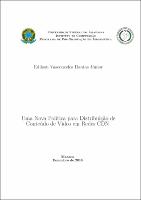| ???jsp.display-item.social.title??? |


|
Please use this identifier to cite or link to this item:
https://tede.ufam.edu.br/handle/tede/6973Full metadata record
| DC Field | Value | Language |
|---|---|---|
| dc.creator | Dantas Junior, Edilson Vasconcelos | - |
| dc.creator.Lattes | http://lattes.cnpq.br/7720424402069681 | por |
| dc.contributor.advisor1 | Feitosa, Eduardo Luzeiro | - |
| dc.contributor.advisor1Lattes | http://lattes.cnpq.br/5939944067207881 | por |
| dc.contributor.referee1 | Melo, Cesar Augusto Viana | - |
| dc.contributor.referee1Lattes | http://lattes.cnpq.br/0097703442306179 | por |
| dc.contributor.referee2 | Queiroz, Alexandre Passito de | - |
| dc.contributor.referee2Lattes | http://lattes.cnpq.br/7507000181049352 | por |
| dc.date.issued | 2018-12-14 | - |
| dc.identifier.citation | DANTAS JÚNIOR, Edilson Vasconcelos. Uma nova política para distribuição de conteúdo de vídeo em redes CDN. 2018. 54 f. Dissertação (Mestrado em Informática) - Instituto de Computação, Universidade Federal do Amazonas, Manaus, 2018. | por |
| dc.identifier.uri | https://tede.ufam.edu.br/handle/tede/6973 | - |
| dc.description.resumo | Entre os mais variados conteúdos atualmente disponíveis para acesso na Internet, o vídeo é sem dúvida a mídia mais consumida. Para que isso seja possível, existem grandes provedores CDN (Content Delivery Network) com uma infraestrutura robusta capaz de entregar conteúdo de vídeo com baixa latência e alta disponibilidade. Entretanto, em regiões onde existem limitações de infraestrutura os grandes provedores CDN não estão presentes e existem poucos investimentos para expansão da capacidade de distribuição em tais localidades, como é o caso da Região Amazônica. Nesse sentido, o trabalho teve como objetivo propor uma metodologia para avaliar o impacto de combinar estratégias de distribuição de conteúdo de vídeo, utilizando redes CDN, segmentação do conteúdo e distribuição seletiva considerando as condições de largura de banda do cenário, como meio de distribuição de conteúdo para cenários com infraestrutura limitada, visando garantir a distribuição de conteúdo multimídia a localidades com limitação de infraestrutura. Após analisar as condições de infraestrutura limitada e os principais cenários encontrados na literatura, foram escolhidos e implementados três (03) cenários de distribuição. Em seguida foi realizada a escolha do simulador, uma vez que a implementação de uma arquitetura CDN necessita de uma estrutura operacional complexa, o que envolve a utilização de equipamentos, links de comunicação e tecnologias para gerenciamento do conteúdo. Um terceiro momento foi realizada a medição do desempenho da rede CDN para identificar sua capacidade em atender os clientes com o conteúdo a ser replicado, além de possibilitar o monitoramento e gerenciamento do desempenho de uma rede CDN. De acordo com os resultados apresentados nas simulações, ao realizar a distribuição dos vídeos em todos as versões, sem a utilização de segmentação, os tempos necessários para transmissão foram os maiores apresentados, especialmente nos cenários com menor velocidade de largura de banda disponível. Mostrou ainda que ao se utilizar outras tecnologias em conjunto com redes CDN, as métricas obtidas eram melhores e que quando os vídeos distribuídos, foram segmentados, o processo de distribuição obteve métricas ainda melhores. | por |
| dc.description.abstract | Among the most varied content currently available for access on the Internet, video is undoubtedly the most consumed media. For this to be possible, there are large CDN (Content Delivery Network) providers with a robust infrastructure capable of delivering video content with low latency and high availability. However, in regions where there are infrastructure limitations, large CDN providers are not present and there are few investments to expand distribution capacity in such locations, as is the case in the Amazon Region. In this sense, the objective of this work was to propose a methodology to evaluate the impact of combining video content distribution strategies using CDN networks, content segmentation and selective distribution considering the scenario bandwidth conditions as a means of distributing content for scenarios with limited infrastructure, in order to guarantee the distribution of multimedia content to locations with infrastructure limitations. After analyzing the conditions of limited infrastructure and the main scenarios found in the literature, three (03) distribution scenarios were chosen and implemented. Then the choice of the simulator was made, since the implementation of a CDN architecture requires a complex operational structure, which involves the use of equipment, communication links and technologies for content management. A third step was to measure the performance of the CDN network to identify its ability to serve customers with the content to be replicated, as well as to enable the monitoring and performance management of a CDN network. According to the results presented in the simulations, when distributing the videos in all versions without the use of segmentation, the times required for transmission were the highest presented, especially in the scenarios with the lowest bandwidth available. It also showed that when using other technologies in conjunction with CDN networks, the obtained metrics were better and that when the distributed videos were segmented, the distribution process got even better metrics. | eng |
| dc.format | application/pdf | * |
| dc.thumbnail.url | https://tede.ufam.edu.br//retrieve/28466/Disserta%c3%a7%c3%a3o_EdilsonDantasJunior_PPGI.pdf.jpg | * |
| dc.language | por | por |
| dc.publisher | Universidade Federal do Amazonas | por |
| dc.publisher.department | Instituto de Computação | por |
| dc.publisher.country | Brasil | por |
| dc.publisher.initials | UFAM | por |
| dc.publisher.program | Programa de Pós-graduação em Informática | por |
| dc.rights | Acesso Aberto | por |
| dc.rights.uri | http://creativecommons.org/licenses/by/4.0/ | - |
| dc.subject | CDN | por |
| dc.subject | Distribuição de conteúdo | por |
| dc.subject | Infraestrutura de redes | por |
| dc.subject | Content delivery network | eng |
| dc.subject.cnpq | CIÊNCIAS EXATAS E DA TERRA: CIÊNCIA DA COMPUTAÇÃO: SISTEMAS DE COMPUTAÇÃO: TELEINFORMÁTICA | por |
| dc.title | Uma nova política para distribuição de conteúdo de vídeo em redes CDN | por |
| dc.type | Dissertação | por |
| Appears in Collections: | Mestrado em Informática | |
Files in This Item:
| File | Description | Size | Format | |
|---|---|---|---|---|
| Dissertação_EdilsonDantasJunior_PPGI.pdf | 4.41 MB | Adobe PDF |  Download/Open Preview |
This item is licensed under a Creative Commons License





